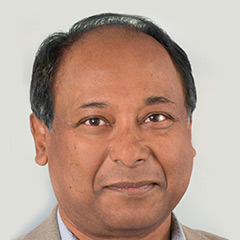The Ability to Navigate the In-Between Spaces

Topics
Column
How can large organizations most effectively connect decision-makers across functions, divisions, and business units — not to mention with other companies, governments, and other external stakeholders?
Efforts to do so usually require organizational innovations.
For example, when General Electric Co. (GE) became one of the first U.S. multinational companies to enter Myanmar after that country reconnected with the global economy, executives from GE’s Global Growth Organization (GGO) played key roles. Because critical gaps existed in the country’s basic infrastructure, they connected the dots across GE’s businesses to structure and sequence health care and aviation projects with power projects. Simultaneously, they arranged training in 21st-century technologies and management practices for Myanmar-based executives, professionals, and government officials.
GGO executives based in Southeast Asia represent all of GE to all 10 member countries of the Association of Southeast Asian Nations (ASEAN) — a group whose collective GDP exceeds $2.4 trillion. Because GGO executives represent all businesses, they have the ability to create and lead growth projects that require coordinated action by multiple GE divisions, and by other companies, governments, and funding agencies. That setup also enables GE to operate as a leaner entity than it would be with a traditional matrix structure in each country. By effectively connecting decision-makers across various networks, GGO executives enable the movement of goods and services, monies, and — most importantly — knowledge and information.
Four Key Leadership Attributes for Leading Across Networks (and Silos and Borders)
Which leadership attributes are necessary for an executive to work effectively across a variety of functions, organizations, and actors? While the Myanmar effort was particularly complex, in most of their work, GE GGO executives in Southeast Asia have demonstrated exceptional command of four key leadership attributes that typically aren’t strong points for executives in traditional, non-networked, organizations.
Let’s look at those four attributes and the strengths GGO executives bring to each one.
-
They readily navigate the “in-between spaces” — the gaps not covered by specialists. In most companies, executives rise through the ranks by specializing in a single function or dedicating themselves to specific business units. As a part of its leadership development, GE normally looks for people who are the “T-type” leaders that IDEO CEO Tim Brown has championed: They are knowledgeable in a few different disciplines (the horizontal cap of the T) and have deep expertise in one area (the vertical part of the T). GGO executives are an important variation of this theme: They have broader knowledge of the company’s businesses and their context, at the expense of some depth. Stated differently, their T’s have wider wingspans and shorter tails. This “horizontal mindset” enables them to help businesses anticipate the unexpected, spread ideas, and share resources for scale.
Being generalists with some depth isn’t easy. The GGO executives for Southeast Asia need knowledge of a region with economic systems that range from socialist to capitalist and political ideologies that range from absolute monarchy to freewheeling democracies. To get a sense of the challenge that presents, consider this: A bridge links the island nation of Singapore to its nearest neighbor, Malaysia, but the national and business cultures of the two countries are very different. GGO executives also need to understand each GE division’s capabilities and talent bases, and the potential of each division to contribute to national development agendas. Therefore, they must regularly rebalance the capabilities and knowledge they themselves must possess against those they can leave to specialists.
-
They have “high say-do ratios” — a phrase often used by former GE vice chairman and GGO president John Rice to mean that they are good at following through and getting things done. This characteristic isn’t trite: As generalists, GGO executives must partner internally and externally with professionals who have a great deal of expertise in specific fields, and because many experts distrust generalists, such relations are often fraught with skepticism.
GGO executives build networks by being willing to talk to anybody with expertise, regardless of the titles on their business cards. This is a big deal in the ASEAN, where local organizations usually have rigid hierarchies. To earn the trust of experts, they listen carefully to understand what the experts consider important. In response, they only make promises that are consistent with resource constraints. This means that externally and internally, they prioritize what is feasible instead of pursuing all that might be possible.
-
They are multilingual and culturally knowledgeable across countries and business disciplines. Understanding the local cultures and languages of Southeast Asia is key to navigating the public and private sectors of ASEAN countries. Most GGO executives speak at least two of the region’s 10 major languages. Their broad cultural awareness helps them tune in to local customs and needs. Moreover, they build deep relationships with local experts who can contribute vital insights that enhance local market relevance and help mediate the idiosyncrasies of decision-making. For example, GE’s entry into Myanmar, and its subsequent expansion in that country, would not have been possible if GGO executives did not have localized expertise.
In an equally important endeavor, GGO executives learn the functional, professional, and business jargon used by the groups they work with. In all organizations, jargon makes intragroup communication efficient, but lowers the effectiveness of intergroup communication. People who can converse with each group in its own jargon make organizations stronger because they better understand each group’s key needs and constraints and can bridge differences effectively. Indeed, Japanese companies have relied on, and have cultivated, this uncommon capability for decades.
-
They are problem-finders, learners, and intrapreneurs. GGO executives have to embrace working on resource-constrained projects shrouded in uncertainty. Creating new demand requires the ability to spot problems, test hypotheses, and run pilots. Executives must be comfortable with unclear personal incentives because many of these projects take years to bear fruit.
Beyond helping to develop products and services suited for ASEAN markets, GGO executives have identified and established enhanced project financing capabilities in the region. They take advantage of global networks and relationships with financial institutions to bring in financing from other parts of the world.
The GGO’s culture is mission-focused: Individuals are encouraged to work collaboratively, and they can look beyond reporting structures to achieve goals. Top GGO executives in the ASEAN reach down two or three levels across GE to find promising talent. Their recruits grow into their roles through formal learning, deployments to ongoing projects, and rotational assignments. They also attend some senior-level events to learn how to build effective personal networks.
Of the four key leadership attributes, the first, the ability to readily navigate the “in-between spaces,” is the dominant leadership characteristic of successful people in networked organizations. But leaders can’t be good at navigating the in-between spaces if they don’t also master the other three attributes — or if their companies don’t provide the necessary support to do so.
Get Updates on Transformative Leadership
Evidence-based resources that can help you lead your team more effectively, delivered to your inbox monthly.
Please enter a valid email address
Thank you for signing up
The Coming Talent Challenge
For GE, the GGO has been an essential response to the reality that work today is distributed across many national and organizational boundaries. Indeed, it is acknowledged as having played a key role in driving the company’s growth outside the developed West.
Because digital technologies are increasing the complexity and ambiguity of challenges that executives face every day, other large companies have developed, or are seeking, similar solutions. I believe that most employers will eventually need to recruit or develop a critical mass of executives whose T-type profiles feature broader wingspans and shorter tails.
Companies will face a major challenge if they rely on traditional performance evaluation and talent identification systems to find people like that. Those systems don’t do a good job of objectively and consistently flagging those kinds of leadership profiles. Until they put the right processes in place to overcome that challenge, companies will simply have to identify the right people by following the adage “It takes one to know one.”
Making the effort is important. Our world is politically and economically multipolar and multicultural. Knowledge and resources are locked away in unexpected places. It takes a new kind of leader to find them and bring them together.

